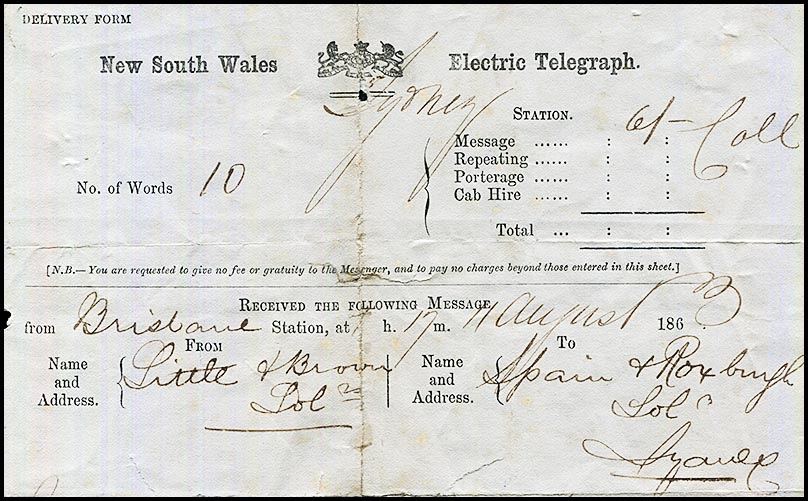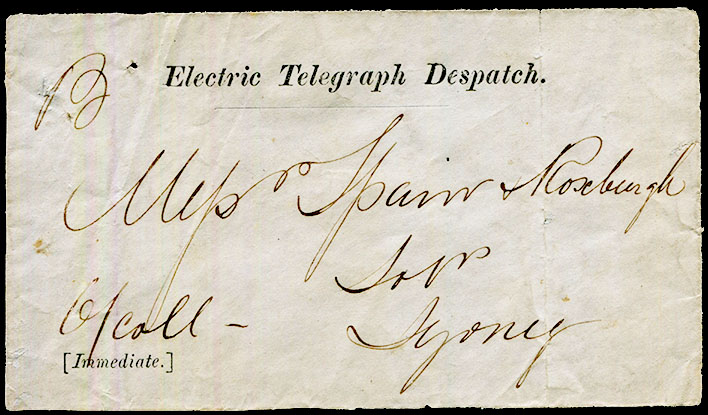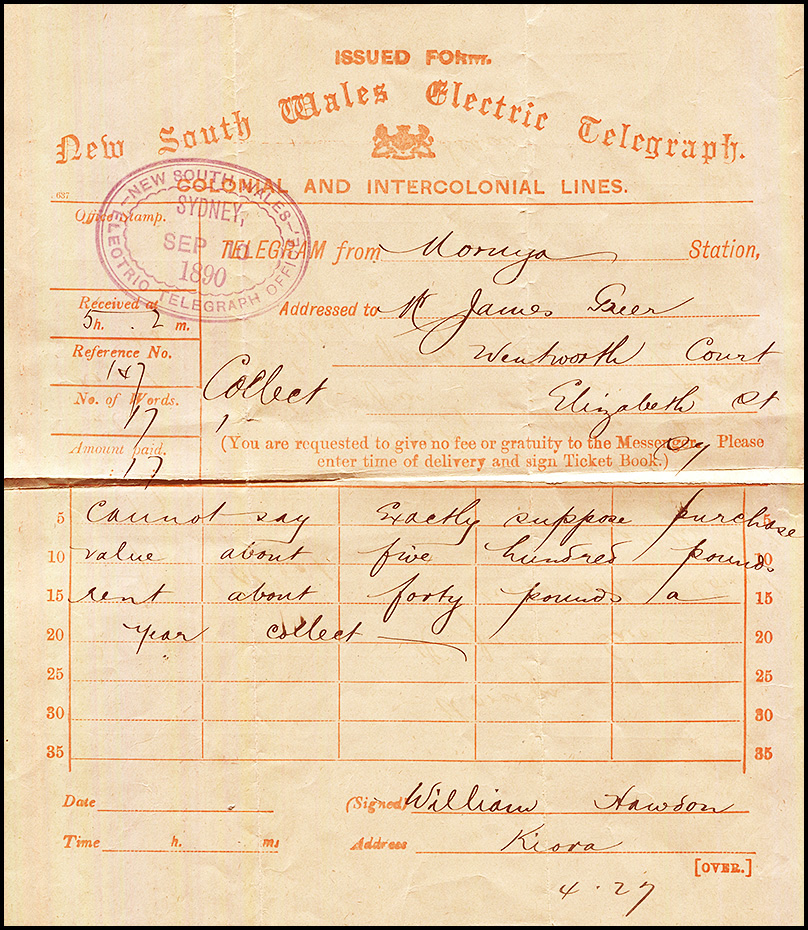Instructional marking - COLLECT.
- Australia 1901-1988
- New South Wales
- Queensland
- South Australia
- Tasmania
- Victoria
- Western Australia
- International
- Special aspects
The COLLECT facility was available to users of the telegraph system to send a telegram and charge the cost to the recipient of the telegram. This facility was referred to as COLLECT TELEGRAMS.
Such a use was not unusual and the practice was adopted in all Australian Colonies as well as being continued well into the Australian era - and of course with more watchfulness and more forms.
In Colonial days, all the Colonies provided the COLLECT facility by simply requiring a sender to annotate the transmission form with the word COLLECT. The Operator would calculate the cost and add that to the message on the transmission form after the added word. The recipient of such a telegram would then be notified that a telegram had arrived for them or a messenger would bring it to the address shown and the recipient would pay the required amount before being able to access their telegram. If the potential recipient of a Collect Telegram refused to pay the cost, the sender had to pay together with any other costs.
There are always those in the community who wish to rort any system for their own greedy interests. The Collect system was sometimes used to advertises goods and services to people who paid the fee necessary before realising what the message was.
1. New South Wales regulations:
Even though the concept of having a recipient pay the costs of a telegram was accepted from the beginning (probably a continuation of the previous practice of the recipient of a letter paying for its delivery) official Regulations do not appear to have been issued. Hence the practice continued for some time with the only proviso for Collect Telegrams really being "in case of emergency or distress".
A new ruling was Gazetted to come into effect as from 1 October 1885:
"Telegraph messages must be pre-paid by postage stamps; and this, it is claimed will be of great public benefit. Hitherto the time of the various offices was considerably taken up in checking accounts with other stations; but under the new arrangement all the time will be given to attending to the public. A good deal of trouble and confusion through the practice of having "collect" telegrams (which has never been a recognised rule of the department except in the case of a distressed person) will be avoided and the system generally will be so much simplified that greater attention to public business can be given and more general satisfaction will be the consequence".
Finally, on 13 April 1886, the Gazette carried the following:
"COLLECT" TELEGRAMS.
In accordance with the provisions of the 6th section of the Electric Telegraph Act, the following regulation in regard to "Collect" Telegrams has been adopted, to date from the 1st May next:
"Payment of charges in advance will be required, except for replies to interrogatory messages on which the sender has written 'Reply paid here'.
In case of emergency or distress, however, persons may be allowed to send messages to be paid for by the receiver.
The senders of 'Collect' telegrams will be required to guarantee the charge in case of non-payment by the addressees. No charge will be made for the date, address or signature on any telegram lodged for transmission within the colonies".
In August 1892, the Telegraph Department in Sydney issued a notice to the effect that "in future all collect telegrams to Victoria, except replies to messages containing the words "reply paid" must be refused as the Victorian department will decline to receive them".
The system of Collect telegrams was suspended in New South Wales for some time from 1 October 1893 when the new practice of pre-paying transmission costs using postage stamps was introduced. No collect telegrams could then be accepted for transmission except in reply to those received which stated 'Reply paid' in the message. Naturally that message had to be produced when the response to it was tendered for transmission to facilitate accounting.
It was not long before exceptions were allowed - and where could that have been? In November 1893, the Postmaster-General allowed members of Parliament to send collect telegrams but stopped the same facility being extended to the general public.
In Parliament of 17th November 1893, Mr Kidd said that "members of Parliament were subjected to such inconvenience and expense by having to prepay telegrams sent in answer to inquiries for information on public matters, an alteration had been made in the telegraph regulations which would permit of the acceptance from members of Parliament of "collect" messages, i.e., on which the charges were to be paid by the addressees instead of by the senders. It was not considered desirable to extend the same privilege to the public, excepting in case of emergency or distress". Soon after, the Chamber of Commerce called on the Postmaster-General to re-instate the system of Collect Telegrams in the same way as had been done for Members of Parliament and for the Press. See also the argument for the system for shipping.
The "Collect Telegram" was however re-introduced in a modified form in October 1894. The new Regulations stated that:
"Telegrams addressed to places within the colony may, under special circumstances or in case of emergency, be taken from the sender, if the latter be known to the officer in charge, with the word 'Collect' written thereon and, in such cases, the value of the telegram will be collected from the receiver. But before the telegram is accepted, the sender will be required to sign an undertaking on a printed form provided for the purpose, that in the event of the Department being unable to collect the amount, he or she will be responsible for the payment thereof and for the cost of the message advising the Department of the non-payment by the receiver.
Collect messages for the adjoining Australian colonies can only be accepted in case of distress or great emergency, and of course subject to the above conditions".
2. The COLLECT annotation used during the NSW Colonial period.
Not many examples of COLLECT telegrams are recorded for New South Wales.
|
|
|
A wonderful (possibly apochropal) story about a Collect Telegram was printed in the Armidale Express of 2 August 1878:
"I was rather amused the other day by a draft telegram which was handed to me. The sender was so very "excited" that I thought he had been chased by the Inspector of Nuisances.
The telegram was evidently addressed to a very dear friend: it was short and sweet and ran thusly: "You infernal scoundrel". I suggested the advisability of drawing it somewhat milder, as the telegraph master would probably decline to send such a message!
He crossed it out and wrote "You diabolical thief" evidently under the impression that the amendment was milder than the original. Fancy a man having to pay for a collect telegram of that sort"!


